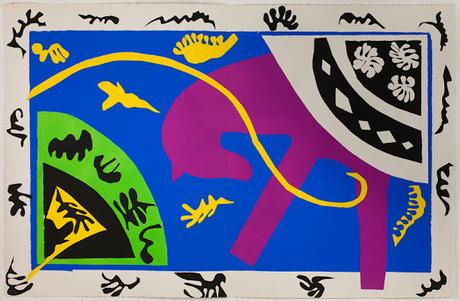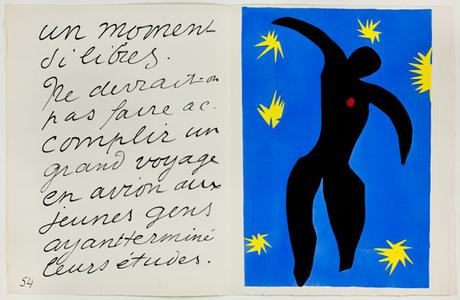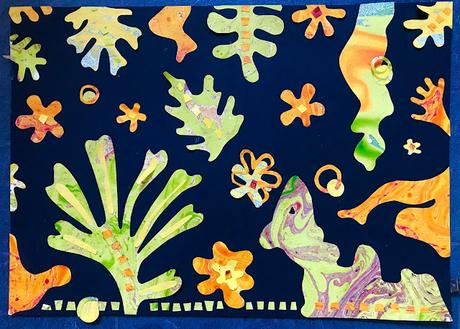Henri Matisse (1869 -1954) was a French multi-disciplinary artist. He was a painter, sculptor and printmaker. In later years he drew with scissors. Firstly, he would plan and draw the elements in a separate notebook then painted, often with gouache (pigments bound in water-soluble gum with white for opaqueness) on to papers. Using scissors with great speed he would cut shapes, then carefully arrange and shift them about utilising pins to temporarily hold the pieces in place until he was happy with the composition. Matisse would call these vibrant and lively images, ‘cut-outs’.The cut-outs were originally created as first drafts for several painting commissions. It was a way of working out ideas for larger works. Eventually he began to choose the cut-outs as the final artwork. This was an innovative technique and radical at that time. It allowed for greater simplicity and abstraction of a subject, then easy rearrangement of shapes without redrawing.I suspect that I first become acquainted with Matisse on one of my many visits to the Art Institute of Chicago (AIC) in the 1970s. The AIC has over 200 of Matisse’s works in its collection that are examples across his career ranging from his early paintings, drawings, sculptures to his later cut-outs, particularly from Jazz, the only book written and illustrated by the artist. It is a limited-edition art book published by Tériade in Paris (1947). 270 copies were printed with text and 100 copies of only the images.The book includes 20 plates that illustrate the circus, alongside the artist’s thoughts and poetry notes on the process of making the images. So where does ‘jazz’ come into this? Well, according to Peter Carr, “[t]he ‘jazz’ element can instead be found in the improvisational techniques seen throughout the book, connecting expressionist art and the musical improvisation found in jazz.”(1)
Horse, Rider and Clown from Jazz (2) - Henry Matisse
Art Institute of Chicago
The pochoir (stencil) technique and gouache were used in reproducing Matisse’s cut-outs for Jazz. “With pochoir printing, the hand application of layers of pigment created dazzling effects that the camera or printing press could never replicate.”(3)Icarus from Jazz (4) - Henri Matisse
Art Institute of Chicago
I learnt more about Matisse in 2002 at the Matisse Picasso exhibition at Tate Modern that was a fascinating exploration of the two artists interesting and complex relationship. Then in 2020, I signed up for a Henri Matisse Online: Painting With Scissors workshop facilitated by The London Drawing Group. The session was led by Frances Stanfield. There were people who tapped in from all over the world. We were asked to work alongside the facilitator, experimenting with our own painted papers that we had created prior to the workshop. I used papers painted with gouache and also marbled papers that I had made several years ago that had been squirreled away in a drawer. Giving myself permission to play leisurely with paper, scissors and glue was very satisfying.Experiment from London Drawing Group's Matisse Online: Painting With Scissors Workshop
Kate Eggleston-Wirtz
I’ve had many encounters with Matisse over the years and continue to find his work inspirational.
Matisse
A painter, a sculptor
who drew with scissors,
a lover of colour
and shifter of shapes;
pin up girls and more
with gentle hands
he moved them.
Thank you for reading.
KateJ
(1) https://www.sothebys.com/en/articles/matisses-jazz-the-flowing-rhythms-of-expressionism
(2) https://www.artic.edu/artworks/230694/horse-rider-and-clown-from-jazz(3) https://risd.libguides.com/pochoir
(4) https://www.artic.edu/artworks/230697/icarus-from-jazz
Email ThisBlogThis!Share to TwitterShare to Facebook



